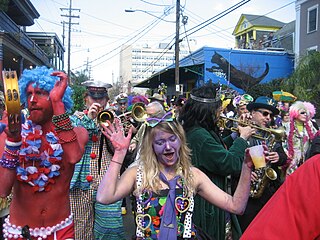
Mardi Gras is the final day of Carnival ; it thus falls on the day before the beginning of Lent on Ash Wednesday. Mardi Gras is French for "Fat Tuesday", reflecting the practice of the last night of consuming rich, fatty foods in preparation for the Christian fasting season of Lent, during which the consumption of such foods is avoided.
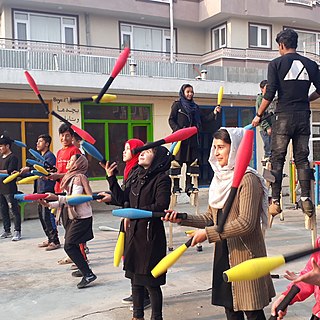
Juggling is a physical skill, performed by a juggler, involving the manipulation of objects for recreation, entertainment, art or sport. The most recognizable form of juggling is toss juggling. Juggling can be the manipulation of one object or many objects at the same time, most often using one or two hands but other body parts as well, like feet or head. Jugglers often refer to the objects they juggle as props. The most common props are balls, clubs, or rings. Some jugglers use more dramatic objects such as knives, fire torches or chainsaws. The term juggling can also commonly refer to other prop-based manipulation skills, such as diabolo, plate spinning, devil sticks, poi, cigar boxes, contact juggling, hooping, yo-yo, hat manipulation and kick-ups.

Cockfighting is a blood sport involving domesticated roosters as the combatants. The first documented use of the word gamecock, denoting use of the cock as to a "game", a sport, pastime or entertainment, was recorded in 1634, after the term "cock of the game" used by George Wilson, in the earliest known book on the sport of cockfighting in The Commendation of Cocks and Cock Fighting in 1607. But it was during Magellan's voyage of discovery of the Philippines in 1521 when modern cockfighting was first witnessed and documented for Westerners by the Italian Antonio Pigafetta, Magellan's chronicler, in the Kingdom of Taytay.

Shrove Tuesday is the final day of Shrovetide, marking the end of pre-Lent. Lent begins the following day with Ash Wednesday. Shrove Tuesday is observed in many Christian countries through participating in confession; the ritual burning of the previous year's Holy Week palms; finalizing one's Lenten sacrifice; as well as eating pancakes and other sweets.

Bull-baiting is a blood sport involving pitting a bull against dogs with the aim of attacking and subduing the bull by biting and holding onto its nose or neck, which often resulted in the death of the bull.
Dwarf-tossing, also called midget-tossing, is a pub/bar attraction or activity in which people with dwarfism, wearing special padded clothing or Velcro costumes, are thrown onto mattresses or at Velcro-coated walls. Participants compete to throw the person with dwarfism the farthest. Dwarf-tossing was started in Australia as a form of pub entertainment in the early 1980s. A related, formerly practiced activity was dwarf-bowling, in which a person with dwarfism was placed on a skateboard and used as a bowling ball.
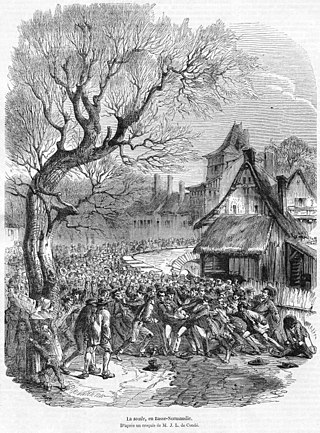
La soule, later choule, is a traditional team sport that originated in Normandy and Picardy. The ball, called a soule, could be solid or hollow and made of either wood or leather. Leather balls would be filled with hay, bran, horse hair or moss. Sometimes the balls had woolen pompons.

Medieval football is a modern term used for a wide variety of the localised informal football games which were invented and played in England during the Middle Ages. Alternative names include folk football, mob football and Shrovetide football. These games may be regarded as the ancestors of modern codes of football, and by comparison with later forms of football, the medieval matches were chaotic and had few rules.

A blood sport or bloodsport is a category of sport or entertainment that involves bloodshed. Common examples of the former include combat sports such as cockfighting and dog fighting, and some forms of hunting and fishing. Activities characterized as blood sports, but involving only human participants, include the ancient Roman gladiatorial games.
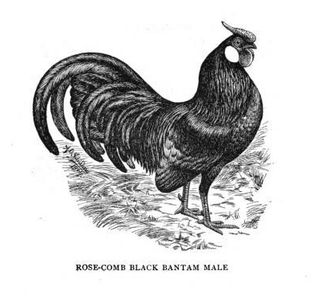
The Rosecomb is a breed of chicken named for its distinctive comb. Rosecombs are bantam chickens, and are among those known as true bantams, meaning they are not a miniaturised version of a large fowl. Rosecombs are one of the oldest and most popular bantam breeds in showing, and thus have numerous variations within the breed. An ornamental chicken, they are poor egg layers and not suited for meat production.

Basque rural sports, known as Deportes Rurales in Spanish or Herri Kirolak in Basque, is the term used for a number of sports competitions rooted in the traditional lifestyles of the Basque people. The term force basque is used in French.
Nickanan Night is a Cornish feast, traditionally held during Shrovetide, specifically on Shrove Monday.
In the Elizabethan era (1558–1603), there was a wide range of leisure activities entertaining both the nobility and the common classes. Among these leisure activities were animal fighting, team sports, individual sports, games, dramatics, music and the arts.
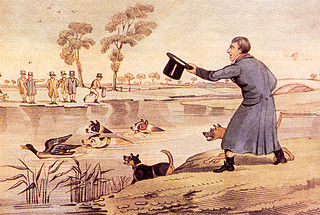
Duck-baiting is a blood sport involving the baiting of ducks against dogs.
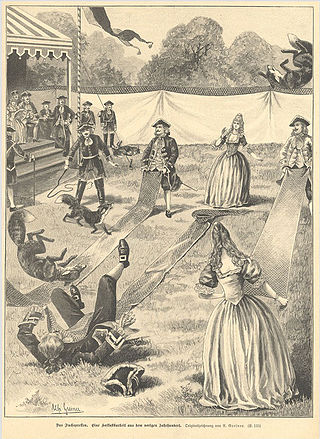
Fox tossing was a competitive blood sport popular in parts of Europe in the 17th and 18th centuries. It involved throwing live foxes and other animals high into the air. It was practiced by members of the aristocracy in an enclosed patch of ground or in a courtyard, using slings with a person on each end to catapult the animal upwards. It was particularly popular for mixed couples, even though it was hazardous for the people launching the animals as the terrified animals would often turn on the participants. The result was often fatal for the tossed animals.
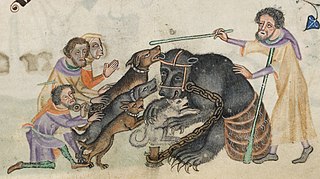
Bear-baiting is a blood sport in which a chained bear and one or more dogs are forced to fight one another. It may also involve pitting a bear against another animal. Until the 19th century, it was commonly performed in Great Britain, Sweden, India, Pakistan, and Mexico among others.
1821 in sports describes the year's events in world sport.

Goose pulling was a blood sport practiced in parts of the Netherlands, Belgium, England, and North America from the 17th to the 19th centuries. It originated in the 12th century in Spain and was spread around Europe by the Spanish Third. The sport involved fastening a live goose with a well-greased head to a rope or pole that was stretched across a road. A man riding on horseback at a full gallop would attempt to grab the bird by the neck in order to pull the head off. Sometimes a live hare was substituted.

The Stamford bull run was a bull-running and bull-baiting event in the English town of Stamford, Lincolnshire. It was held on St Brice's Day, for perhaps more than 600 years, until 1839. A 1996 Journal of Popular Culture paper refers to the bull run as a festival, in "the broader context of the medieval if not aboriginal festival calendar", though works written during and shortly after the activity's later years variously describe it as a "riotous custom", a "hunt", an "old-fashioned, manly, English sport", an "ancient amusement", and – towards its end – an "illegal and disgraceful ... proceeding".

Cockfighting in India primarily takes place in January, coinciding with Makara Sankranti. The practice is widespread in coastal districts of Andhra Pradesh, including Krishna, Guntur, East Godavari and West Godavari districts, despite being illegal in India.

















